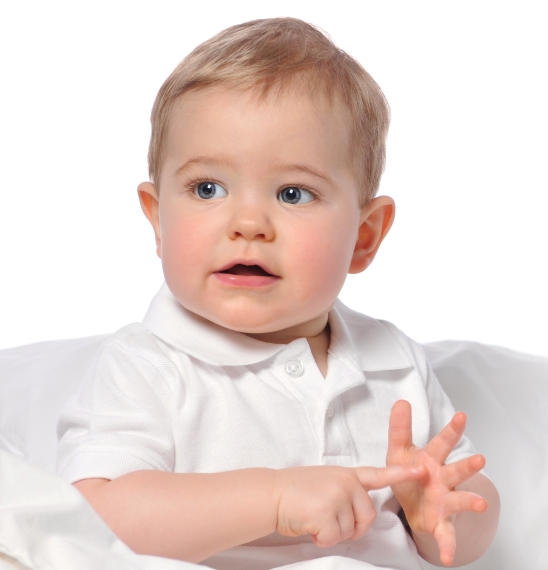You’ve heard about it on TV, and you’ve seen some parents doing it with their baby in the park, at the playground or in the grocery store. Even your local library is offering a class about it next month. But is signing with your baby something worth checking out?
We talked to some baby sign language experts about the advantages and the challenges associated with learning this new language, as well as how and when to get started. Read on to find out if it’s for you.
Big-Time Benefits
For anyone who has ever questioned the usefulness of signing with a young child, insiders point to a myriad of short- and long-term benefits. “Using sign language with hearing babies is an effective, temporary bridge to communication that greatly reduces frustration for babies, parents and other primary caregivers,” says Nancy Hanauer, founder of Hop to Signaroo (www.hoptosignaroo.com). “This makes life so much easier when parents know exactly what their babies want.”
In the long term, studies from leading researchers in American Sign Language (ASL) show that babies who learn sign language also learn to speak earlier, develop larger vocabularies and acquire better reading and spelling skills by the time they reach elementary school age. “This is due to the jumpstart on language that signing gave them before speech was physically possible,” notes Hanauer.
Signing helps foster a stronger bond between parent and child right from the start, thanks to more eye contact and increased communication. According to Hanauer, families also report that the “terrible twos” aren’t so terrible because their toddlers didn’t have two years of built-up frustration of not being understood. “This can result in calmer, more self-confident children in those formative years and beyond,” she adds.
Starting to Sign
How do you know when and if your baby is ready to begin signing? According to Lora Heller, founder of My Baby Fingers (www.mybabyfingers.com), it’s typically when a child is between 8-10 months of age. “Babies will be exploring with repetitive hand gestures at pertinent times in the day,” she explains.
In Hanauer’s experience, she has seen babies sign as early as five months old. “At that age, babies understand language far more than we’ve previously given them credit for,” she notes. Parents will begin to notice that their child looks at them when their name is called, or that their child will look for the family pet when asked “Where’s the doggie?” “Once you realize that your baby understands some of what you’re saying, it’s a great time to start signing,” she adds.
Of course, learning something new along with your child can pose its own set of challenges. “Some parents fear they are not doing it right,” says Jennifer Hatfield, a speech pathologist and president of Therapy and Learning Services (www.therapyandlearningservices.com). She advises parents to find a good resource and jump right in. “Start with signs that are easily incorporated in your routine and have more meaning to the infant, like milk, eat and more. Be consistent and don’t worry about perfection,” she adds.
Aside from the fear of not signing correctly, there’s the misconception that teaching a baby to sign before they can speak will slow down their speech. Hanauer advises using true ASL vocabulary and speaking and signing at the same time. “All babies are hardwired to speak, and a baby who hears an average of 4,500 words throughout the course of the day will never ‘choose’ signing over speech,” she affirms.
Relying on Resources
If you’ve decided you’d like to give signing a try, but don’t know where to look, experts recommend a mix of resources—a program or kit, supplemented with online support—works best. Hatfield swears by classes at varying levels of experience. “Starting out with other likeminded parents, followed by toddler classes, allows for socialization for both you and your child,” she says.
Hanauer recommends opting for materials and classes based on ASL—not on gestures. “This insures that parents are learning from individuals and with materials that demonstrate respect and understanding of the hearing-impaired community that we’re borrowing this amazing language from,” she notes.
As you progress in your signing abilities, Heller suggests keeping a journal of your baby’s signs and spoken words, and adding to it regularly. After eight months, a baby could typically be learning 1-3 new signs per month, and after one year of age, that number could jump to 1-3 new signs each week. “It’s important to realize that the amount varies with personality,” she observes. “There must be consistent signing modeled by the parents, too.”
Moving forward, parents can expect to see an automatic shift in their developing child’s capacity for signing and how that translates into speech. “Once babies’ vocal chords are fully functioning and they know you understand their spoken words, they’ll naturally drop the signs and focus on the speech skills they’re so proud of,” enthuses Hanauer. “But what a beautiful, less frustrating bridge to communication ASL can be in the meantime!”




